Ⓒ 2023 Kyligence, Inc. All rights reserved.
The Ultimate Guide to Shopify KPIs

Introduction
As a Shopify store owner or manager, you know how important it is to keep track of your business's performance. One way to do that is by monitoring key performance indicators (KPIs). KPIs are measurable values that help you understand how well your business is performing and identify areas for improvement. Tracking KPIs on Shopify can provide valuable insights into your store's sales, traffic, customer behavior, and more. By understanding these metrics, you can make data-driven decisions to optimize your online store and grow your business. In this ultimate guide to Shopify KPIs, we'll cover the most essential metrics you should be tracking and why they matter. Whether you're new to e-commerce or an experienced seller looking for ways to improve your store's performance, this guide will give you everything you need to know about tracking KPIs on Shopify.
Key KPIs every Shopify store should track
As a Shopify store owner or manager, it is crucial to keep track of key performance indicators (KPIs) in order to gauge the success and growth of your business. Three important KPIs that every Shopify store should track are conversion rate, average order value, and customer lifetime value.
Conversion rate
The conversion rate measures the percentage of website visitors who complete a desired action on your site, such as making a purchase or filling out a contact form. A higher conversion rate indicates that your website is successfully converting visitors into customers. In order to improve your conversion rate, consider optimizing the user experience on your site by improving page load times, simplifying checkout processes, and offering clear calls-to-action.
Average order value
Average order value (AOV) measures the average amount spent per transaction on your site. This metric is important because it can directly impact revenue growth for your business. By increasing the AOV through tactics such as upselling or offering free shipping at certain price thresholds, you can boost revenue without necessarily needing more traffic or customers.
Customer lifetime value
Customer lifetime value (CLV) measures how much revenue an individual customer will generate over their entire relationship with your business. This KPI takes into account factors such as repeat purchases and referrals from satisfied customers. By focusing on increasing CLV through strategies like personalized marketing campaigns and loyalty programs, you can not only increase overall revenue but also build long-term relationships with loyal customers.
Overall, tracking these three KPIs -conversion rate,Average Order Value,and Customer Lifetime Value- can help you make data-driven decisions when it comes to growing and optimizing your Shopify store's performance.Collecting accurate data about these metrics allows you to identify areas where improvements need to be made in terms of user experience,customer service,and marketing strategies.By consistently reviewing these key indicators,you'll be able to stay ahead in today's competitive e-commerce landscape while keeping up with changing consumer trends.Effective measurement practices coupled with continuous optimization efforts will help ensure that both short-and long-term goals are met,resulting in greater profitability for years to come!
How to set benchmarks and goals for KPIs
Setting benchmarks and goals for KPIs is crucial for measuring the success of your Shopify store. The first step is to identify the KPIs that are most relevant to your business objectives. Once you have identified these KPIs, it is important to set realistic benchmarks and goals for each of them.
One best practice is to look at industry benchmarks to gain an understanding of what is achievable within your industry. This can help you set realistic goals that are achievable, yet still challenging enough to drive growth. However, it is important to note that not all benchmarks are created equal. It is essential to use benchmarks that are relevant to your specific business model and target audience.
Another best practice is to set goals based on historical data. By analyzing your store's performance over time, you can identify trends and patterns that can inform future goals. For example, if your store experiences a spike in sales during the holiday season, you may want to set a goal to increase sales by a certain percentage during that time period.
When setting benchmarks and goals for KPIs, it is important to consider the resources available to you. If you have a limited budget for advertising or marketing, it may be unrealistic to set a goal to increase website traffic by 50% in one month. Instead, you may want to set a goal to increase traffic by a smaller percentage over a longer period of time.
It is also important to communicate your benchmarks and goals with your team. By involving your team in the goal-setting process, you can create a sense of ownership and accountability. This can help motivate your team to work towards achieving these goals.
Tips for tracking and analyzing KPIs in Shopify
Introduction
Tracking and analyzing key performance indicators (KPIs) is crucial for the success of any Shopify store. KPIs provide insights into how well a store is performing, what areas need improvement, and where to focus efforts to increase sales and revenue. In this section, we will discuss some tips for tracking and analyzing KPIs in Shopify.
Define your goals
Before you start tracking KPIs in Shopify, it's important to define your goals. What do you want to achieve with your store? Is it increased traffic, higher conversion rates or more customer engagement? Once you have clear objectives in mind, you can select relevant metrics that align with those goals.
Select relevant metrics
There are numerous metrics available in Shopify that can be tracked but not all of them may be relevant for every store. It's essential to choose the right metrics based on your business goals and industry benchmarks. Some popular KPIs include website traffic sources, average order value (AOV), conversion rate by device type or channel etc.
Use visualization tools
Data visualization tools help make sense of complex data sets by presenting them visually through graphs, charts or other visual representations. These tools allow users to quickly identify trends over time or spot patterns that might otherwise go unnoticed. By using such tools like Google Analytics dashboard integration with Shopify merchants can get insight easily
Compare against benchmarks
Benchmarks refer to industry standards for various KPIs across different sectors such as retail e-commerce or fashion e-commerce etc.. Comparing your own performance against established benchmarks helps identify areas requiring improvement while also setting realistic targets for future growth.
Monitor regularly
Monitoring KPIs regularly allows stores owners/managers not only track progress towards their goal but also enables early detection of problems before they become critical issues affecting overall business performance..
By following these tips mentioned above businesses can gain valuable insights into their customers' behavior which ultimately leads towards better decision making regarding marketing strategies aimed at improving their bottom line through increased sales revenue generated from successful campaigns driven by meaningful data analysis & interpretation skills!
Best practices for optimizing KPIs to drive business growth
When it comes to optimizing KPIs, there are some proven strategies that Shopify store owners and managers can implement to drive business growth and improve overall performance. One of the first steps is to identify which KPIs are most important for your specific business goals. This will vary depending on factors such as industry, target audience, and product offerings.
Once you have identified your key KPIs, it's important to set achievable targets or benchmarks for each one. This will help you track progress over time and make adjustments as needed. Regular monitoring of these metrics is also crucial in order to identify trends or areas where improvements can be made.
Another best practice for optimizing KPIs is to focus on quality over quantity when it comes to website traffic or social media engagement. It's better to have a smaller number of high-quality leads than a large volume of low-quality ones that aren't likely to convert into customers.
In addition, utilizing data analytics tools can help uncover insights about customer behavior patterns and preferences. This information can then be used to tailor marketing efforts towards those specific audiences in order to improve conversion rates.
Finally, collaboration between different departments within the organization (such as sales, marketing, and operations) is essential in order to ensure that everyone is working towards the same overarching goals when it comes to improving KPI performance.
By implementing these best practices for optimizing KPIs, Shopify store owners and managers can take their businesses' growth potential up a notch while making more informed decisions based on accurate data analysis.
Conclusion
In conclusion, tracking and analyzing KPIs on Shopify is crucial for store owners and managers to measure the success of their e-commerce businesses. By monitoring metrics such as conversion rate, customer acquisition cost, average order value, and revenue per visitor, they can identify areas for improvement and make data-driven decisions. It's important to remember that KPIs should be aligned with business goals and regularly reviewed to ensure that they are still relevant. Additionally, it's essential to avoid measuring vanity metrics that don't provide meaningful insights into the performance of a Shopify store. Overall, effective KPI tracking can help improve the bottom line of an online business by optimizing marketing strategies or improving website functionality based on insight gained from analyzed data.
See Also
Analyze Your Business Metrics With Kyligence Zen Today
